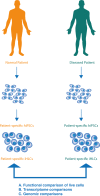Stem Cell Strategies to Evaluate Idiosyncratic Drug-induced Liver Injury
- PMID: 26355943
- PMCID: PMC4521249
- DOI: 10.14218/JCTH.2014.00012
Stem Cell Strategies to Evaluate Idiosyncratic Drug-induced Liver Injury
Abstract
The host-dependent nature of idiosyncratic drug-induced liver injury (iDILI) suggests that rare genetic polymorphisms may contribute to the disease. Indeed, a few mutations in key genes have already been identified using conventional human genetics approaches. Over 50 commonly used drugs can precipitate iDILI, making this a substantial medical problem. Only recently have human induced pluripotent stem cells been used as a research tool to discover novel iDILI genes and to study the mechanisms of iDILI in vitro. Here we review the current state of stem cell use in the investigation of iDILI, with a special focus on genetics. In addition, the concerns and difficulties associated with genetics and animal model research are discussed. We then present the features of patient-specific pluripotent stem cells (which may be derived from iDILI patients themselves), and explain why these cells may be of great utility. A variety of recent approaches to produce hepatocyte-like cells from pluripotent cells and the associated advantages and limitations of such cells are discussed. Future directions for the use of stem cell science to investigate iDILI include novel ways to identify new iDILI genes, a consideration of epigenetic impacts on iDILI, and the development of new and improved strategies for the production of hepatocytes from human pluripotent cells.
Keywords: DILI; Embryonic stem cell; Genetics; Toxicity; iPS.
Conflict of interest statement
Figures


Similar articles
-
Monocyte-derived hepatocyte-like cells for causality assessment of idiosyncratic drug-induced liver injury.Gut. 2016 Sep;65(9):1555-63. doi: 10.1136/gutjnl-2015-309528. Epub 2015 Jun 4. Gut. 2016. PMID: 26045135 Clinical Trial.
-
Human Leucocyte Antigen Genetics in Idiosyncratic Drug-Induced Liver Injury with Evidence Based on the Roussel Uclaf Causality Assessment Method.Medicines (Basel). 2024 Apr 11;11(4):9. doi: 10.3390/medicines11040009. Medicines (Basel). 2024. PMID: 38667507 Free PMC article. Review.
-
Utilization of causal reasoning of hepatic gene expression in rats to identify molecular pathways of idiosyncratic drug-induced liver injury.Toxicol Sci. 2014 Jan;137(1):234-48. doi: 10.1093/toxsci/kft232. Epub 2013 Oct 17. Toxicol Sci. 2014. PMID: 24136188
-
Evaluation of a human in vitro hepatocyte-NPC co-culture model for the prediction of idiosyncratic drug-induced liver injury: A pilot study.Toxicol Rep. 2017 Feb 12;4:89-103. doi: 10.1016/j.toxrep.2017.02.001. eCollection 2017. Toxicol Rep. 2017. PMID: 28959630 Free PMC article.
-
DILI prediction in drug development: present and future.Expert Opin Drug Metab Toxicol. 2025 Jun;21(6):665-676. doi: 10.1080/17425255.2025.2495955. Epub 2025 Apr 20. Expert Opin Drug Metab Toxicol. 2025. PMID: 40253704 Review.
Cited by
-
Hepatocyte-like cells derived from human induced pluripotent stem cells using small molecules: implications of a transcriptomic study.Stem Cell Res Ther. 2020 Sep 11;11(1):393. doi: 10.1186/s13287-020-01914-1. Stem Cell Res Ther. 2020. PMID: 32917265 Free PMC article.
-
Research Progress of Pharmacogenomics in Drug-Induced Liver Injury.Front Pharmacol. 2021 Sep 6;12:735260. doi: 10.3389/fphar.2021.735260. eCollection 2021. Front Pharmacol. 2021. PMID: 34552491 Free PMC article. Review.
-
Mechanism and Therapeutic Opportunities of Histone Modifications in Chronic Liver Disease.Front Pharmacol. 2021 Nov 23;12:784591. doi: 10.3389/fphar.2021.784591. eCollection 2021. Front Pharmacol. 2021. PMID: 34887768 Free PMC article. Review.
-
Idiosyncratic Hepatocellular Drug-Induced Liver Injury by Flucloxacillin with Evidence Based on Roussel Uclaf Causality Assessment Method and HLA B*57:01 Genotype: From Metabolic CYP 3A4/3A7 to Immune Mechanisms.Biomedicines. 2024 Sep 27;12(10):2208. doi: 10.3390/biomedicines12102208. Biomedicines. 2024. PMID: 39457521 Free PMC article. Review.
-
Induced pluripotent stem cells for therapy personalization in pediatric patients: Focus on drug-induced adverse events.World J Stem Cells. 2019 Dec 26;11(12):1020-1044. doi: 10.4252/wjsc.v11.i12.1020. World J Stem Cells. 2019. PMID: 31875867 Free PMC article. Review.
References
-
- Bell LN, Chalasani N. Epidemiology of idiosyncratic drug-induced liver injury. Semin Liver Dis. 2009;29:337–347. 10.1055/s-0029-1240002. - DOI - PMC - PubMed
-
- Navarro VJ, Senior JR. Drug-related hepatotoxicity. New Engl J Med. 2006;354:731–739. 10.1056/NEJMra052270. - DOI - PubMed
-
- Sakatis MZ, Reese MJ, Harrell AW, Taylor MA, Baines IA, Chen L, et al. Preclinical strategy to reduce clinical hepatotoxicity using in vitro bioactivation data for >200 compounds. Chem Res Toxicol. 2012;25:2067–2082. 10.1021/tx300075j. - DOI - PubMed
-
- Kaplowitz N. Idiosyncratic drug hepatotoxicity. Nature Rev Drug Discov. 2005;4:489–499. 10.1038/nrd1750. - DOI - PubMed
-
- Watkins P. Idiosyncratic liver injury: Challenges and approaches. Toxicol Pathol. 2005;33:1–5. 10.1080/01926230590888306. - DOI - PubMed
Publication types
LinkOut - more resources
Full Text Sources
Other Literature Sources
